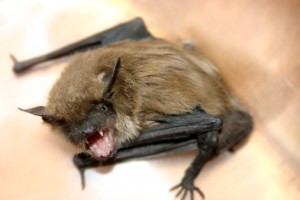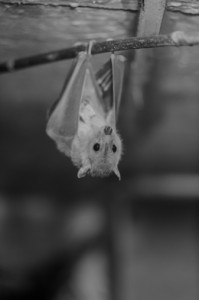 Bats are among the most unique , misunderstood and most interesting of all mammals. For the most part, bats are harmless. They do become a major pest problem when they take up residency within buildings or homes. Their scratching and squeaking noises they create are annoying. Their urine and droppings cause persistant odors which stain walls and ceilings as well as attract insects. Other bat colonies can be attracted to these odors also, even after the original colony is broken up. Individuals may also come in contact with a rabid bat.
Bats are among the most unique , misunderstood and most interesting of all mammals. For the most part, bats are harmless. They do become a major pest problem when they take up residency within buildings or homes. Their scratching and squeaking noises they create are annoying. Their urine and droppings cause persistant odors which stain walls and ceilings as well as attract insects. Other bat colonies can be attracted to these odors also, even after the original colony is broken up. Individuals may also come in contact with a rabid bat.
Bats are “winged handed.” They are the only mammals capable of true flight. Bats possess functional eyes but rely on their “radar” to navigate their swift flights. Most bats roost in caves, trees, and other natural shelters. Few may breed within occupied buildings or homes during the warmer weathered months. The brown bat is the species most frequently encountered by the homeowner.
The brown bat is relatively large measuring four inches in length and having a wing span between 12 and 14 inches. It weighs only one ounce. The wings and fur are dark brown and the ears are blackish. Little brown bats are common and are about three inches long, chocolate brown and weigh 1/4 ounce.
Any bat is potentially dangerous due to fact it may be infected with rabies. Rabies can occur in bats without showing any symptoms. Any bat which acts in an abnormal manner such as fluttering around on the ground should be avoided. The local health department should contacted if rabid bats are suspected in a building or home.
Accumulation of bat droppings in attics or soil creates an environment suitable for a fungal organism. This organism can cause the lung disease “Histoplasmosis” in people, dogs, cats and other animals. Severe cases can be fatal. This fungus can be present in droppings that have accumulated for long periods of time. A large bat roost in an attic or cave is especially dangerous since fungal spores may be drawn into the lungs when people breathe in the dust in these roosting areas.
 Bats usually enter structures during the first warm days of spring. The majority of these bats are female ready to give birth. The maternity colonies may have a few individual bats to several hundred. Bats are born during June and July. Big brown bats have one or two young per bat and mature within three to seven weeks. They remain in their roost all summer. In the fall, males increase in numbers and mating begins. When temperature drops in mid October – November, bats leave their summer roost and travel to hibernation quarters. These quarters can be hollow trees, rock crevices, drainage pipes, caves, buildings or homes. Most bats live an average of 4 – 10 years. Bats usually select homes or buildings near water, streams, lakes, ponds, and where insects are found in adequate numbers. Roost sites within a home or building may be exposed areas such as ceiling joints, roof rafters or in roof and ceiling voids or brick voids. Bats emerge from structures at dusk, find nearby watering areas, and return to their roost by dawn. During the day, they are restful. Bats will return to their warm weather roost year after year. These roosts have the ability to increase in size by 50% year over year. For this reason it is important to address a bat pest problem as soon as possible.
Bats usually enter structures during the first warm days of spring. The majority of these bats are female ready to give birth. The maternity colonies may have a few individual bats to several hundred. Bats are born during June and July. Big brown bats have one or two young per bat and mature within three to seven weeks. They remain in their roost all summer. In the fall, males increase in numbers and mating begins. When temperature drops in mid October – November, bats leave their summer roost and travel to hibernation quarters. These quarters can be hollow trees, rock crevices, drainage pipes, caves, buildings or homes. Most bats live an average of 4 – 10 years. Bats usually select homes or buildings near water, streams, lakes, ponds, and where insects are found in adequate numbers. Roost sites within a home or building may be exposed areas such as ceiling joints, roof rafters or in roof and ceiling voids or brick voids. Bats emerge from structures at dusk, find nearby watering areas, and return to their roost by dawn. During the day, they are restful. Bats will return to their warm weather roost year after year. These roosts have the ability to increase in size by 50% year over year. For this reason it is important to address a bat pest problem as soon as possible.
Bats enter a home or building because there are gaps and spaces that allow them to access the structure. They are capable of entering through an opening as small as 3/8 inches high by 1 inch wide or an opening that is 1/2 inch in diameter.
BAT MANAGEMENT and THE EXCLUSION PROCESS
Your home is the most important valuable personal asset you may have.
To manage bats it is important to inspect and evaluate the infestation by a pest professional. The following needs to be determined:
1) all possible exit and entry points of bats, 2) structural deficiencies of a building or home, 3) bat roosting site inside the building or home, 4) the size of the colony or infestation and 5) the species of the bat pest.
Two inspections should be done and occur during the day (to determine inside roosting areas) and at dusk (to see where bats are emerging from a building or home.) Bats will roost a distance away from their exit holes, between floors, and in wall voids of a building or home. Both “Primary” and “Secondary” access points must be identified. Primary access points are areas that are being used by the colony for daily egress and ingress into the building or home. Secondary access points are the remaining openings through which the resident bats can enter once the primary areas have been closed up. The Exclusion Process involves the closure of all secondary openings and all but 2 or 3 primary openings. The installation of “Bat Cones” (one-way exit devices) over the primary openings that have been left opened are then placed. After 5 to 7 days, the bat cones are then removed. The 2 or 3 primary openings that the bat cones were covering are also finally removed.
Bat Proofing or Bat Exclusion is the most logical and biologically acceptable way to control bats. The best time of year to bat proof a building or home is either late fall after the bats depart for hibernation or in late winter-early spring before the bats arrive. The objective in controlling bats is to rid a building or home of a colony permanently. Exclusion is the only method that can guarantee this goal.
Bats are protected by both the State and Federal Law.
New Jersey Law prohibits excluding bats from May 1st to August 1st which is their “Baby Season”.


